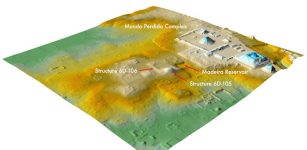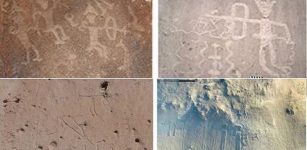Ancient Stone Cylinders Shed New Light On The Invention Of Writing In Mesopotamia
Jan Bartek - AncientPages.com - Writing in Mesopotamia can be traced back to images created by ancient cylinder seals on clay tablets and other artifacts.
A research team from the University of Bologna has discovered a series of connections between these engraved designs, which date back approximately six thousand years, and some signs found in the proto-cuneiform script that developed in Uruk, a city located in present-day southern Iraq, around 3000 B.C.
Background: White Temple ziggurat in Uruk. Credit: tobeytravels - CC BY-SA 2.0 - Front: Example of a cylinder seal (left) and its design imprinted onto clay (right). Credit: Franck Raux 2001 GrandPalaisRmn (Musée du Louvre) - Image compilation AncientPages.com
Their study, published in Antiquity under the title "Seals and signs: tracing the origins of writing in ancient Southwest Asia," offers new perspectives on understanding how writing began. It may assist researchers not only in gaining deeper insights into the meanings behind cylinder seal designs, but also in deciphering many still-unknown signs within proto-cuneiform.
"The conceptual leap from pre-writing symbolism to writing is a significant development in human cognitive technologies," explains Silvia Ferrara, professor in the Department of Classical Philology and Italian Studies at the University of Bologna and lead researcher.
"The invention of writing marks the transition between prehistory and history, and the findings of this study bridge this divide by illustrating how some late prehistoric images were incorporated into one of the earliest invented writing systems."
Uruk, one of the earliest cities to develop in Mesopotamia, played a crucial role throughout the fourth millennium B.C. It influenced a vast area stretching from southwestern Iran to southeastern Turkey. In this region, cylinder seals were crafted—typically from stone and engraved with intricate designs. These cylinders were rolled onto clay tablets to leave an impression of the design.
Photograph of proto-cuneiform tablet showing signs discussed in the article. Credit: CDLI - Cuneiform Digital Library Initiative
Beginning in the mid-fourth millennium B.C., cylinder seals became integral to an accounting system used for tracking the production, storage, and transportation of various consumer goods, especially agricultural and textile products. Within this framework emerged proto-cuneiform: an early form of writing composed of numerous pictographic signs. Despite more than half remaining undeciphered today, proto-cuneiform was primarily used for accounting purposes and is mostly documented in southern Iraq.
"The close relationship between ancient sealing and the invention of writing in southwest Asia has long been recognized, but the relationship between specific seal images and sign shapes has hardly been explored," says Ferrara. "This was our starting question: did seal imagery contribute significantly to the invention of signs in the first writing in the region?"
To find an answer, the researchers conducted a systematic comparison between the designs on the cylinders and proto-cuneiform signs. They aimed to identify correlations that could indicate direct relationships in both graphic form and meaning.
Diagrams of proto-cuneiform signs and their precursors from pre-literate seals. Credit: CDLI - Cuneiform Digital Library Initiative
"We focused on seal imagery that originated before the invention of writing, while continuing to develop into the proto-literate period," add Kathryn Kelley and Mattia Cartolano, both researchers at the University of Bologna and co-authors of the study.
"This approach allowed us to identify a series of designs related to the transport of textiles and pottery, which later evolved into corresponding proto-cuneiform signs."
This discovery reveals, for the first time, a direct link between the cylinder seal system and the invention of writing, offering new perspectives for studying the evolution of symbolic and writing systems.
See also: More Archaeology News
"Our findings demonstrate that the designs engraved on cylinder seals are directly connected to the development of proto-cuneiform in southern Iraq," confirms Silvia Ferrara. "They also show how the meaning originally associated with these designs
The study was published in the journal Antiquity
Written by Jan Bartek - AncientPages.com Staff Writer























